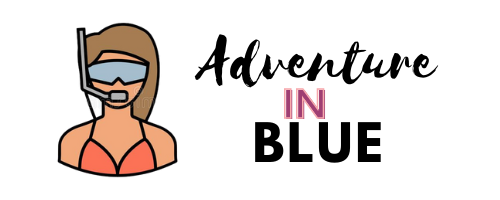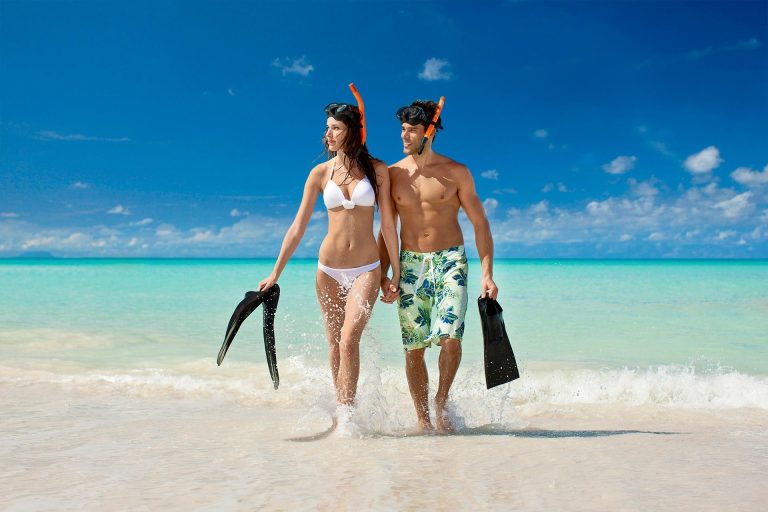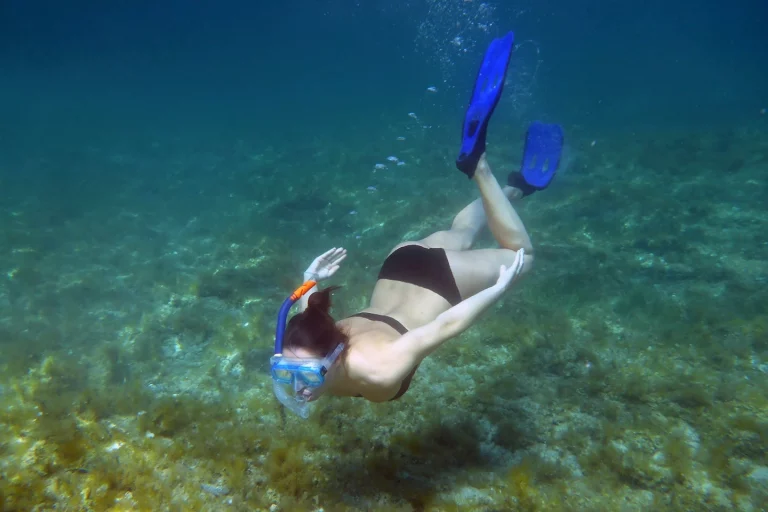Although wearing a full-face snorkel mask might be an interesting novelty, are full-face snorkel masks safe?
One of the most intriguing developments in snorkeling technology recently is the introduction of full-face snorkel masks.
Full-face snorkel masks have a dome that covers your entire face from forehead to chin and an integrated snorkel at the top with a one-way valve that aims to keep out unexpected water while allowing you to breathe normally. While the traditional snorkel masks only cover your eyes and nose and require a separate snorkel tube to connect your mouth to the surface air. You won’t find anything like them in your grandparents’ snorkel kits.
Furthermore, they are praised as being ideal for first-time snorkelers.
It would help if you didn’t consider maintaining a tight seal on your snorkel with the proper pressure from your mouth since the mask will do it for you. The built-in one-way valve prevents nearly all water from entering the snorkel tube, relieving you of that burden. The increased observation window size allows for a more exciting underwater adventure.
These days, full-face snorkel masks seem to be everywhere.
But are full-face snorkel masks safe? Some people have started wondering this because of an apparent correlation between the popularity of full-face snorkel masks and an uptick in snorkeling-related fatalities in some regions. But could it be that people are using full-face snorkel masks? That’s a tricky question with no easy solution.
In Simple words to answer Are full-face snorkel masks safe? Full-face snorkel masks may seem less intimidating in calmer waters, but they can be deadly in rougher waves, especially for inexperienced snorkelers. While you can’t always predict how the water will be, using proper snorkeling gear can ensure you’re as safe as possible.
Can the problems be traced back to the masks themselves? Is the lack of barrier to entry posed by a full-face snorkel mask encouraging inexperienced, potentially dangerous snorkelers to enter the water? Is it possible that the increased mortality rate among snorkelers is attributable to their already having health problems? Could this be a bunch of random occurrences?
It’s a dynamic scenario, leading to sensationalist clickbait headlines like “death masks” and “the finest masks ever.” Here, we’ll look at what little is known about full-face snorkel masks and try to separate fact from fiction.
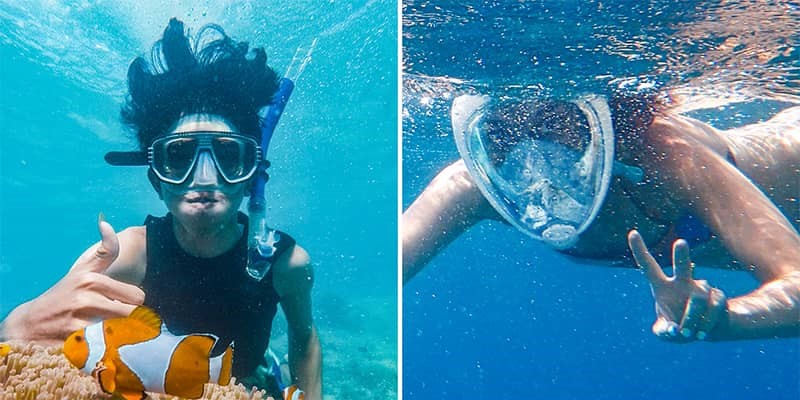
Are full-face snorkel masks safe? 5 big truths & lies
Truth: we don’t know for sure right now
Simply put, we don’t know whether or not full-face snorkel masks are safe or harmful or why.
For instance, the Hawaii Health Department (with Hawaii being one of the leaders in studying the safety of full-face snorkel masks) notes that “there is currently not enough information to prove a direct association to increased risk,” despite acknowledging reports of problems and even drownings when a full-face snorkel mask was being used.” [Source]
However, several Hawaii snorkel tour companies are discouraging and prohibiting the use of full-face snorkel masks on their trips because of the stories they have heard. [Source]
Right now, the concerns are indeed largely based on stories, which makes it tough to draw any definitive conclusions.
Concerns are based mostly on anecdotal evidence, making it difficult to draw firm judgments.
And it’s quite challenging to get adequate information. Extensive Australian researchers concluded that snorkeling is typically safe, finding that “claims of injury from snorkeling are rare.” In 2018, when concerns about the safety of full-face snorkel masks first surfaced, four out of ten deaths associated with snorkeling in Hawaii involved someone wearing a full-face mask [Source]. That’s a very small sample size.
Considering how many individuals go out snorkeling every day, the fact that injury figures are hard to get by is a net positive. In addition, while there were some isolated fatalities before the advent of full-face snorkel masks, they are extremely uncommon and, in the vast majority of cases, may be attributed to previous heart or health conditions [Source].
The fate of the snorkelers who covered their entire faces is also unknown. Full-face snorkel mask data, in particular, will require tracking and analysis. There will probably be a requirement for lab work and data collection. The state of Hawaii is investigating this, but no one has gone very far as to say whether or not it is safe.
Truth: we don’t know for sure right now
Simply put, we don’t know whether or not full-face snorkel masks are safe or harmful or why.
For instance, the Hawaii Health Department (with Hawaii being one of the leaders in studying the safety of full-face snorkel masks) notes that “there is currently not enough information to prove a direct association to increased risk,” despite acknowledging reports of problems and even drownings when a full-face snorkel mask was being used.” [Source]
However, several Hawaii snorkel tour companies are discouraging and prohibiting the use of full-face snorkel masks on their trips because of the stories they have heard. [Source]
Right now, the concerns are indeed largely based on stories, which makes it tough to draw any definitive conclusions.
Concerns are based mostly on anecdotal evidence, making it difficult to draw firm judgments.
And it’s quite challenging to get adequate information. Extensive Australian researchers concluded that snorkeling is typically safe, finding that “claims of injury from snorkeling are rare.” In 2018, when concerns about the safety of full-face snorkel masks first surfaced, four out of ten deaths associated with snorkeling in Hawaii involved someone wearing a full-face mask [Source]. That’s a very small sample size.
Considering how many individuals go out snorkeling every day, the fact that injury figures are hard to get by is a net positive. In addition, while there were some isolated fatalities before the advent of full-face snorkel masks, they are extremely uncommon and, in the vast majority of cases, may be attributed to previous heart or health conditions [Source]. The fate of the snorkelers who covered their entire faces is also unknown.
Full-face snorkel mask data, in particular, will require tracking and analysis. There will probably be a requirement for lab work and data collection. The state of Hawaii is investigating this, but no one has gone very far as to say whether or not it is safe.
Lie: all full-face snorkel masks are the same
One of the first proposed explanations for the difficulties some people have had when using full-face snorkel masks was that a defective valve at the snorkel’s top prevented carbon dioxide from leaving the mask and oxygen from entering.
If this were true, it would be an issue.
This notion may or may not have any merit. The internet is filled with anecdotes from people who have used full-face snorkel masks, and while it’s only speculation, they suggest there may be genuine valve issues. These valve issues appear to be more common in cheap knockoffs of full-face snorkel masks and considerably less common in masks made by reputable companies.
It’s not hard to locate 30+ brands of full-face snorkel masks on Amazon, but many of these companies have sketchy histories and questionable product sources. Any product that becomes widely used, such as full-face snorkel masks, will inevitably inspire imitations. When it comes to the product’s safety, that might be worrisome.
Famous Hawaiian snorkel shop owner: “I receive three or four queries a week from Chinese producers” regarding fake full-face snorkel masks. These are required items that you must transport. I’d appreciate it if you could email me your mailing information. A sample will be sent. No, thank you, is always my standard response. Could you throw them away in the trash? [Source]
Even the most respected makers of full-face snorkel masks have noticed the issue. The full-face mask produced by Head USA “was subjected to rigorous testing protocols… including the measurement of potential CO2 build-up,” the company said. However, the success of this mask “has spawned several low-cost copycat masks… whose expertise, design, and manufacturing experience are unknown.” [Source]
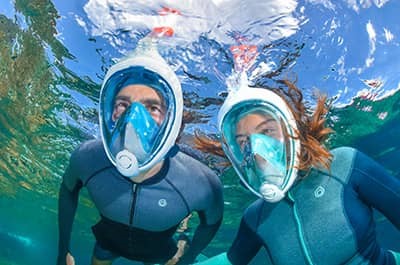
If a full-face mask is something you’re considering, it seems like it would be prudent to restrict your options to those made by companies with proven track records for producing safe products. Head, who just spoke with us, and their Head by Mares’ Seaview (read more about it on Amazon) and Tribord’s Subea Easybreath (also on Amazon) are two of consumers’ most popular masks that feel meet these requirements.
We advise against wearing a full-face snorkel mask for the first time if you don’t know anything about its history with previous divers. This includes any masks you might need, such as those you could rent from a store or snorkeling shop.
No piece of gear or activity on Earth can ever be 100% risk-free, but relying on what others have found to be reliable can increase your chances significantly. In addition, not all full-face snorkel mask manufacturers are equivalent.
(Check out more of our snorkel gear recommendations in our guide, What Snorkel Gear Should I Buy? The Full Guide to Getting Started Affordably.)
Truth: your health is always a factor
One of the challenges in determining the safety of full-face snorkel masks is that they have attracted a lot of different sorts of snorkelers into the water who may not have attempted the sport with traditional equipment.
This is great in principle (more people should be able to enjoy the undersea environment). Still, it may be problematic in practice if the population of full-face mask snorkelers tended to be older or had more preexisting health concerns.
Snorkeling is a great way to get in a complete body exercise, but it does need a certain level of physical fitness. Or else you could endanger yourself.
Almost half of the fatalities associated with snorkeling (60 out of 140) were caused by cardiac-related reasons, and the males over the age of 65 who were the most at risk were found to be the ones with the longest median snorkeling experience. Nearly a quarter of all deaths (34 out of 140) included people with a preexisting heart condition. [Source]
Whether you use a full-face snorkel mask or not, your health should always be your top priority regarding snorkeling safety. If you’re not sure if you’re healthy enough for a regular or full-face snorkel mask, it’s smart to check with your doctor before diving headfirst into a new hobby.
And if you’re not sure, it’s best to stay away from full-face snorkel masks until all your questions are answered.
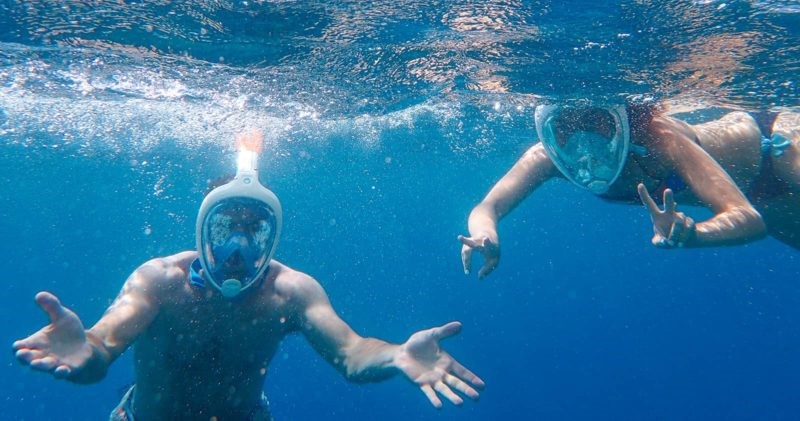
Lie: there’s nothing like full-face snorkel masks
There are various advantages to using a full-face snorkel mask rather than more conventional equipment. For this reason, they’ve recently experienced a surge in popularity.
The main advantages are that the integrated snorkel with the one-way valve on the top of the full-face mask prevents most water from entering your snorkel. The bigger dome covering your face provides you with a wider field of view than a traditional snorkel mask that merely covers your eyes.
Those are big pluses that may greatly improve the snorkeling experience. However, full-face snorkel masks aren’t the only option for creating a similar sensation.
Typically snorkel masks have grown considerably over time, and some now have very, really large lenses that greatly improve visibility.
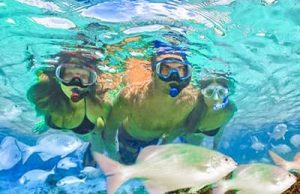
The lenses on many modern versions of classic snorkel masks, such as the TUSA Imprex 3D Hyperdry (Amazon), are substantially bigger than those on earlier models, giving you an underwater view similar to that of a full-face snorkel mask.
For snorkeling, we recommend the TUSA Imprex 3D Hyperdry because of its large lenses (look at it on Amazon). Incredible field of view, a lightweight build, with a purge valve to boot (a feature higher-end masks have that lets you blow any water out of your mask that might seep in). Priced at only roughly $65, it’s a steal.
Next, “dry snorkels” are now the norm rather than the “conventional snorkels,” which were essentially just specialized versions of open tubes. Like the full-face snorkel masks, these dry snorkels include a one-way valve at the top of the tube that prevents water from entering while enabling air to do the same.
If you’re looking for a dry snorkel with your TUSA Imprex 3D Hyperdry mask, consider the TUSA Imprex II Hyperdry snorkel (available on Amazon for about $30). If you’re on a tighter budget, this is a fantastic choice.
However, we are quite particular when choosing a dry snorkel for our comfort and safety, and the Oceanic Ultra-Dry 2 (available on Amazon) is our top option.
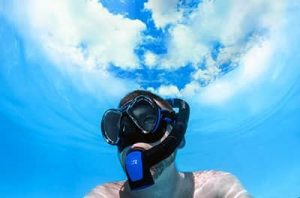
To begin, this high-end snorkel has a wonderful float valve design that effectively prevents water from getting in. However, suppose some water does get in, as it will with any dry snorkel. In that case, the purge valve is perfectly calibrated to allow you to expel the water via the bottom of the tube. The Ultra-Dry 2 costs around $60, but it’s money well spent.
Before jumping into the ocean to go snorkeling, you should make sure you’re in good physical shape and can swim well. However, you may still enjoy many advantages of full-face snorkel masks using dry snorkels and masks with wider lenses, allowing you to pay less attention to your field of view and more to just having a great time in the water.
(To learn more about traditional snorkel masks with larger fields of view, check out The 3 Best Snorkel Masks for All Levels: Beginners, Intermediates & Advanced, or learn more about dry snorkels that work similarly to the snorkels in full-face snorkel masks at The Best Dry Top Snorkel This Year: A Clear Winner.)
Truth: the situation is fluid
In the end, there are some things about full-face snorkel masks that we still don’t know. Because there isn’t a clear solution available just now, that’s the way it is.
It has been advised by certain government authorities, medical professionals, and tour operators that tourists not use full-face snorkel masks out of an abundance of caution. Some are letting individual snorkelers decide for themselves. It is possible to argue for either strategy.
It would help to decide what to do based on your research, health, prior experience, and other personal circumstances. Before making a final call, please read this article and other relevant materials. As a result, the situation is always evolving.
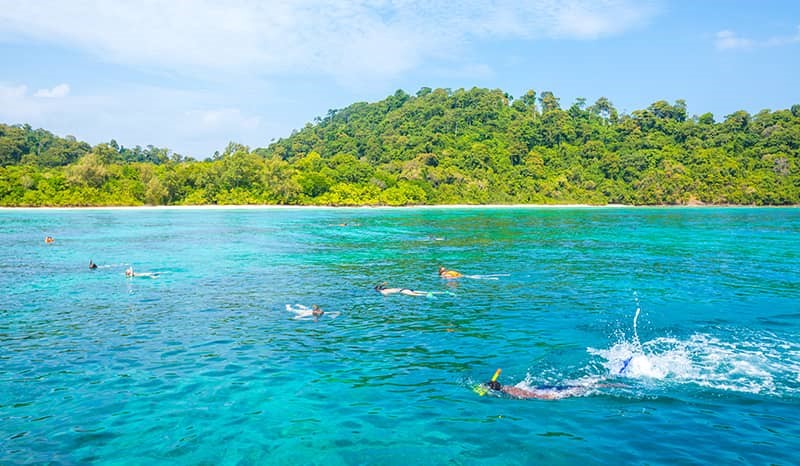
Bonus: my personal experience with full-face snorkel masks
When I go snorkeling, I always use a full-face mask since I have a lot of practice with it. Since I am in this chair and can type this, you may assume I haven’t had any issues.
The full-face snorkel masks I’ve used have worked fine for me. My personal experience with this, although not necessarily indicative of its safety, is all I have to offer.
There have been times when I’ve worn my full-face snorkel mask and had a fantastic time. While the full-face mask isn’t my first choice for snorkeling, it had served me well on more relaxed outings when I didn’t feel like diving deep (which is a lot harder with full-face masks since the air trapped in the face dome makes you more buoyant).
I’ve relied on the Tribord Subea Easybreath (Amazon) For many years. My face fits comfortably inside the mask, and the snorkel valve on top keeps water out of the mask while allowing me to breathe.
While using the mask, I do find that my breathing becomes slightly more labored. Because I need to utilize my lungs to open the snorkel valve, this makes perfect sense. The only thing I do differently when I snorkel is to make sure I’m breathing deeply and steadily, which has never given me any trouble.
I don’t use the mask for intense snorkeling, and I’m in good form and health (diving, longer distances, rougher waters, etc.) If those conditions weren’t met, I’d have to switch to a different sport or buy new gear.
The full-face snorkel mask is a great addition to my snorkeling gear. Although I can’t promise you the same outcome, I wanted to share my story in the hopes that it could bring another person’s perspective to the continuing discussion.
Conclusion
The introduction of full-face snorkel masks has been an exciting development in the sport of snorkeling. Because of the full-face dome’s expansive field of view and the one-way snorkel valve’s ability to block out undesirable water, these goggles are designed to make snorkeling more accessible and pleasurable for a wider audience.
However, the question “are full-face snorkel masks safe?” has been raised after hearing accounts of accidents involving their use. While it’s true that occurrences with full-face snorkel masks (or even more commonplace regular snorkel masks) are still extremely rare, it’s also clear that we don’t yet have enough data to draw any firm conclusions.
In conclusion, if you’re dead bent on attempting a full-face snorkel mask, you should at least get your general health assessed before engaging in an activity like snorkeling. It would help if you only chose masks from well-respected snorkel manufacturers.
Then, before making a choice, ensure you have all the most up-to-date facts. Suppose you’d prefer wait for additional information before committing to a full-face mask. In that case, you now know that bigger, classic snorkel masks used in conjunction with dry snorkels provide many of the same benefits. Since we don’t have a foolproof solution, the decision is ultimately up to you. In any case, we hope you have a fantastic, healthy, and safe day snorkeling!
